2012 PEUGEOT 5008 spare wheel
[x] Cancel search: spare wheelPage 28 of 340
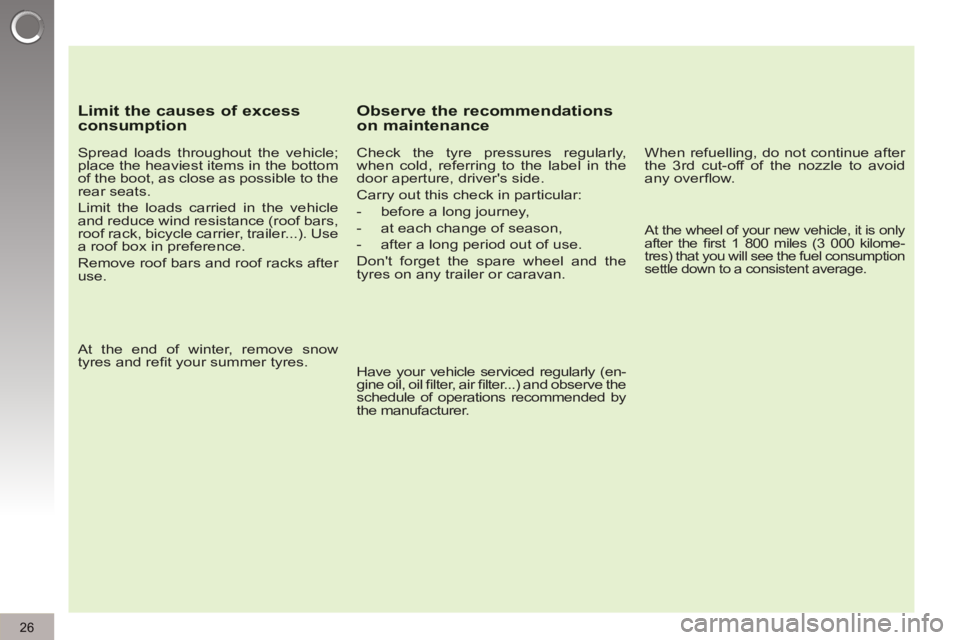
Limit the causes of excess consumption
Spread loads throughout the vehicle;
place the heaviest items in the bottom
of the boot, as close as possible to the
rear seats.
Limit the loads carried in the vehicle
and reduce wind resistance (roof bars,
roof rack, bicycle carrier, trailer...). Use
a roof box in preference.
Remove roof bars and roof racks after
use.
At the end of winter, remove snow
tyres and refi t your summer tyres.
Observe the recommendationson maintenance
Check the tyre pressures regularly,
when cold, referring to the label in the
door aperture, driver's side.
Carry out this check in particular:
- before a long journey,
- at each change of season,
- after a long period out of use.
Don't forget the spare wheel and the
tyres on any trailer or caravan.
Have your vehicle serviced regularly (en-
gine oil, oil fi lter, air fi lter...) and observe the
schedule of operations recommended by
the manufacturer.
When refuelling, do not continue after
the 3 rd cut-off of the nozzle to avoid
any overfl ow.
At the wheel of your new vehicle, it is only
after the fi rst 1 800 miles (3 000 kilome-
tres) that you will see the fuel consumption
settle down to a consistent average.
26
Page 131 of 340
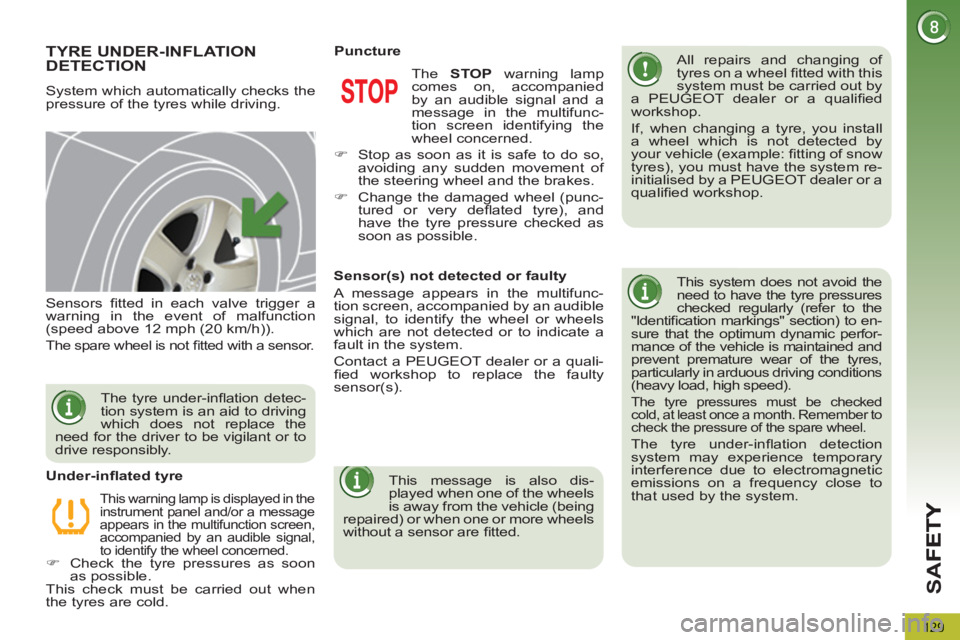
SA
F
129
TYRE UNDER-INFLATION DETECTION
System which automatically checks the
pressure of the tyres while driving.
All repairs and changing of
tyres on a wheel fi tted with this
system must be carried out by
a PEUGEOT dealer or a qualifi ed
workshop.
If, when changing a tyre, you install
a wheel which is not detected by
your vehicle (example: fi tting of snow
tyres), you must have the system re-
initialised by a PEUGEOT dealer or a
qualifi ed workshop.
This system does not avoid the
need to have the tyre pressures
checked regularly (refer to the
"Identifi cation markings" section) to en-
sure that the optimum dynamic perfor-
mance of the vehicle is maintained and
prevent premature wear of the tyres,
particularly in arduous driving conditions
(heavy load, high speed).
The tyre pressures must be checked
cold, at least once a month. Remember to
check the pressure of the spare wheel.
The tyre under-infl ation detection
system may experience temporary
interference due to electromagnetic
emissions on a frequency close to
that used by the system.
Sensors fi tted in each valve trigger a
warning in the event of malfunction
(speed above 12 mph (20 km/h)).
The spare wheel is not fi tted with a sensor.
This warning lamp is displayed in the
instrument panel and/or a message
appears in the multifunction screen,
accompanied by an audible signal,
to identify the wheel concerned.
�)
Check the tyre pressures as soon
as possible.
This check must be carried out when
the tyres are cold.
Under-infl ated tyre The STOP
warning lamp
comes on, accompanied
by an audible signal and a
message in the multifunc-
tion screen identifying the
wheel concerned.
�)
Stop as soon as it is safe to do so,
avoiding any sudden movement of
the steering wheel and the brakes.
�)
Change the damaged wheel (punc-
tured or very defl ated tyre), and
have the tyre pressure checked as
soon as possible.
Puncture
The tyre under-infl ation detec-
tion system is an aid to driving
which does not replace the
need for the driver to be vigilant or to
drive responsibly.
Sensor(s) not detected or faulty
A message appears in the multifunc-
tion screen, accompanied by an audible
signal, to identify the wheel or wheels
which are not detected or to indicate a
fault in the system.
Contact a PEUGEOT dealer or a quali-
fi ed workshop to replace the faulty
sensor(s).
This message is also dis-
played when one of the wheels
is away from the vehicle (being
repaired) or when one or more wheels
without a sensor are fi tted.
Page 190 of 340
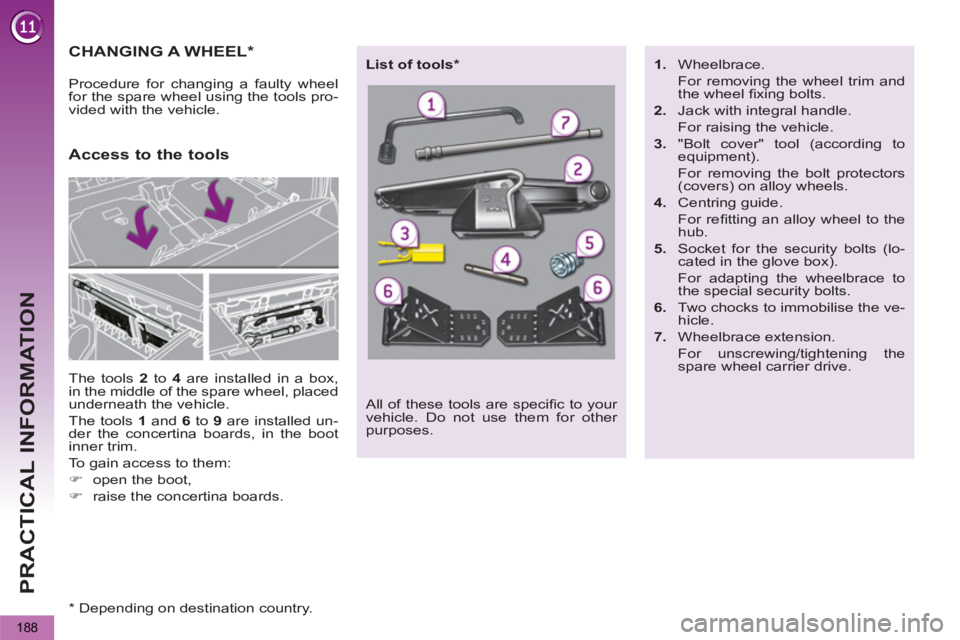
PRACTICAL INFORMATION
188
CHANGING A WHEEL *
The tools 2
to 4
are installed in a box,
in the middle of the spare wheel, placed
underneath the vehicle.
The tools 1
and 6
to 9
are installed un-
der the concertina boards, in the boot
inner trim.
To gain access to them:
�)
open the boot,
�)
raise the concertina boards.
Access to the tools
Procedure for changing a faulty wheel
for the spare wheel using the tools pro-
vided with the vehicle.
All of these tools are specifi c to your
vehicle. Do not use them for other
purposes.
List of tools *
1.
Wheelbrace.
For removing the wheel trim and
the wheel fi xing bolts.
2.
Jack with integral handle.
For raising the vehicle.
3.
"Bolt cover" tool (according to
equipment).
For removing the bolt protectors
(covers) on alloy wheels.
4.
Centring guide.
For refi tting an alloy wheel to the
hub.
5.
Socket for the security bolts (lo-
cated in the glove box).
For adapting the wheelbrace to
the special security bolts.
6.
Two chocks to immobilise the ve-
hicle.
7.
Wheelbrace extension.
For unscrewing/tightening the
spare wheel carrier drive.
*
Depending on destination country.
Page 192 of 340
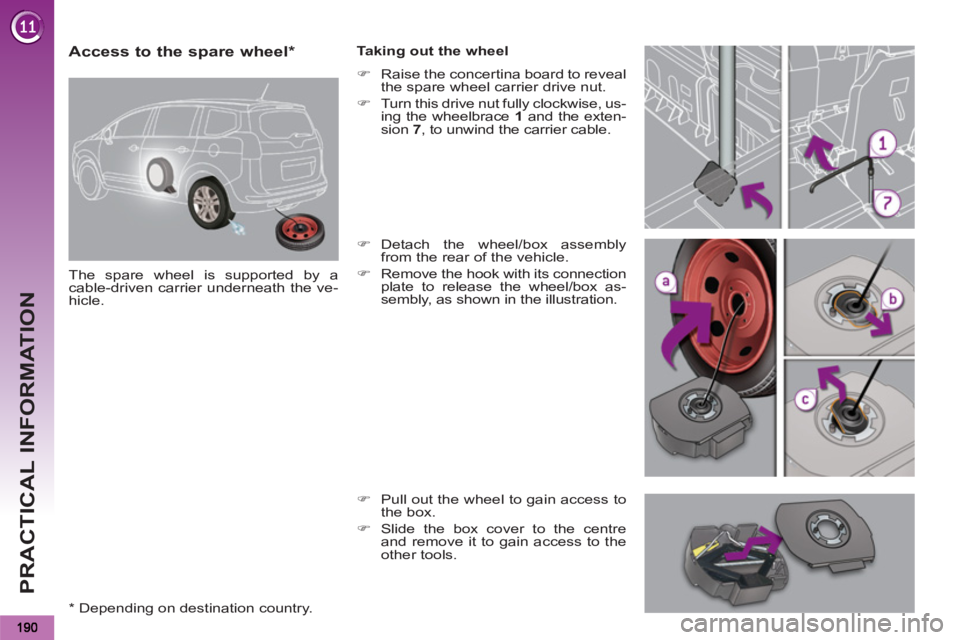
PRACTICAL INFORMATION
Access to the spare wheel *
The spare wheel is supported by a
cable-driven carrier underneath the ve-
hicle.
Taking out the wheel
�)
Raise the concertina board to reveal
the spare wheel carrier drive nut.
�)
Turn this drive nut fully clockwise, us-
ing the wheelbrace 1
and the exten-
sion 7
, to unwind the carrier cable.
�)
Detach the wheel/box assembly
from the rear of the vehicle.
�)
Remove the hook with its connection
plate to release the wheel/box as-
sembly, as shown in the illustration.
�)
Pull out the wheel to gain access to
the box.
�)
Slide the box cover to the centre
and remove it to gain access to the
other tools.
*
Depending on destination country.
Page 193 of 340
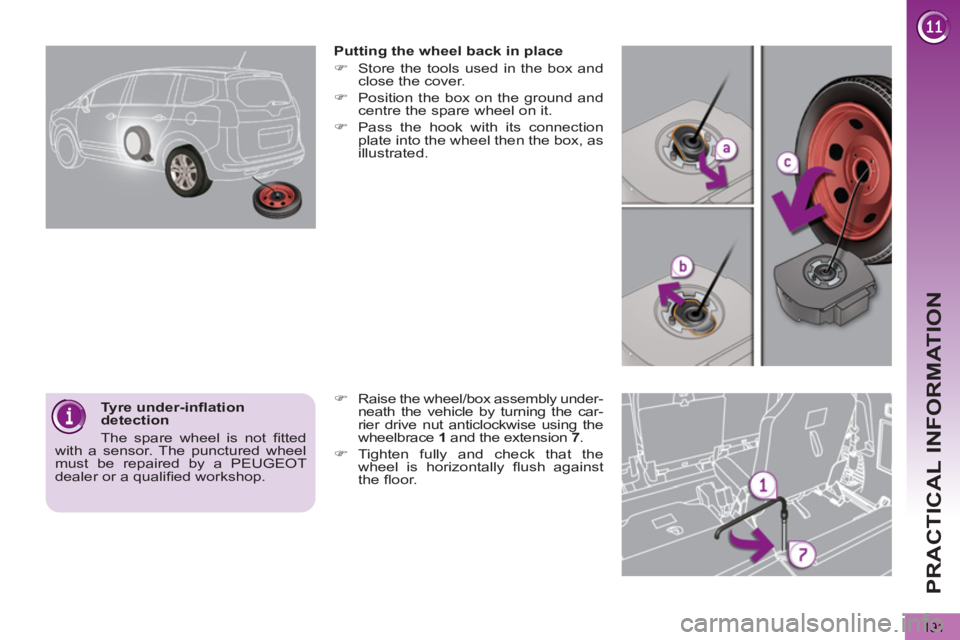
PRACTICAL INFORMATION
191
Tyre under-infl ation
detection
The spare wheel is not fi tted
with a sensor. The punctured wheel
must be repaired by a PEUGEOT
dealer or a qualifi ed workshop.
Putting the wheel back in place
�)
Store the tools used in the box and
close the cover.
�)
Position the box on the ground and
centre the spare wheel on it.
�)
Pass the hook with its connection
plate into the wheel then the box, as
illustrated.
�)
Raise the wheel/box assembly under-
neath the vehicle by turning the car-
rier drive nut anticlockwise using the
wheelbrace 1
and the extension 7
.
�)
Tighten fully and check that the
wheel is horizontally fl ush against
the fl oor.
Page 194 of 340
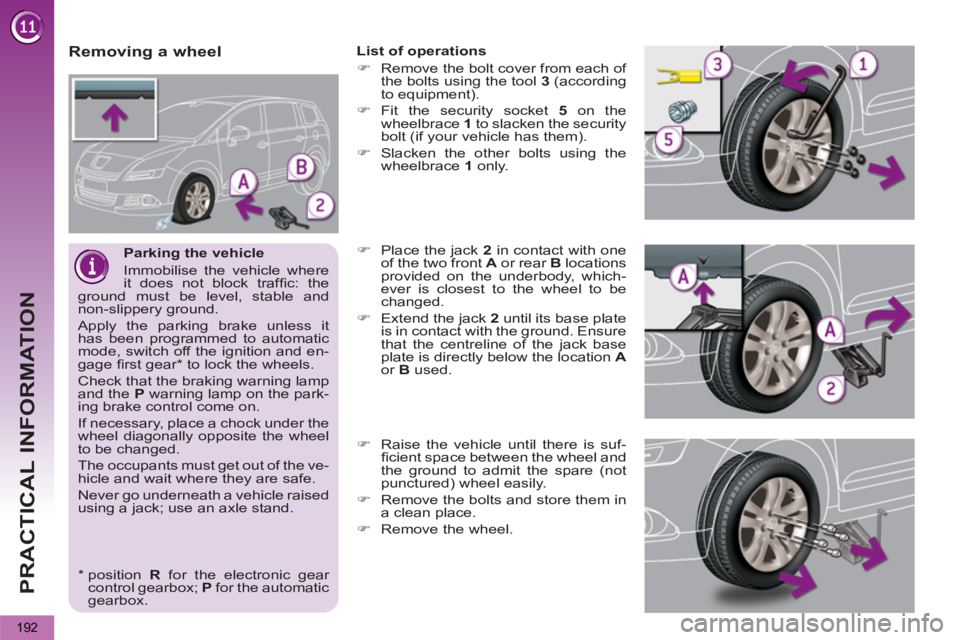
PRACTICAL INFORMATION
192
Parking the vehicle
Immobilise the vehicle where
it does not block traffi c: the
ground must be level, stable and
non-slippery ground.
Apply the parking brake unless it
has been programmed to automatic
mode, switch off the ignition and en-
gage fi rst gear * to lock the wheels.
Check that the braking warning lamp
and the P
warning lamp on the park-
ing brake control come on.
If necessary, place a chock under the
wheel diagonally opposite the wheel
to be changed.
The occupants must get out of the ve-
hicle and wait where they are safe.
Never go underneath a vehicle raised
using a jack; use an axle stand.
Removing a wheel
List of operations
�)
Remove the bolt cover from each of
the bolts using the tool 3
(according
to equipment).
�)
Fit the security socket 5
on the
wheelbrace 1
to slacken the security
bolt (if your vehicle has them).
�)
Slacken the other bolts using the
wheelbrace 1
only.
�)
Place the jack 2
in contact with one
of the two front A
or rear B
locations
provided on the underbody, which-
ever is closest to the wheel to be
changed.
�)
Extend the jack 2
until its base plate
is in contact with the ground. Ensure
that the centreline of the jack base
plate is directly below the location A
or B
used.
�)
Raise the vehicle until there is suf-
fi cient space between the wheel and
the ground to admit the spare (not
punctured) wheel easily.
�)
Remove the bolts and store them in
a clean place.
�)
Remove the wheel.
*
position R
for the electronic gear
control gearbox; P
for the automatic
gearbox.
Page 195 of 340
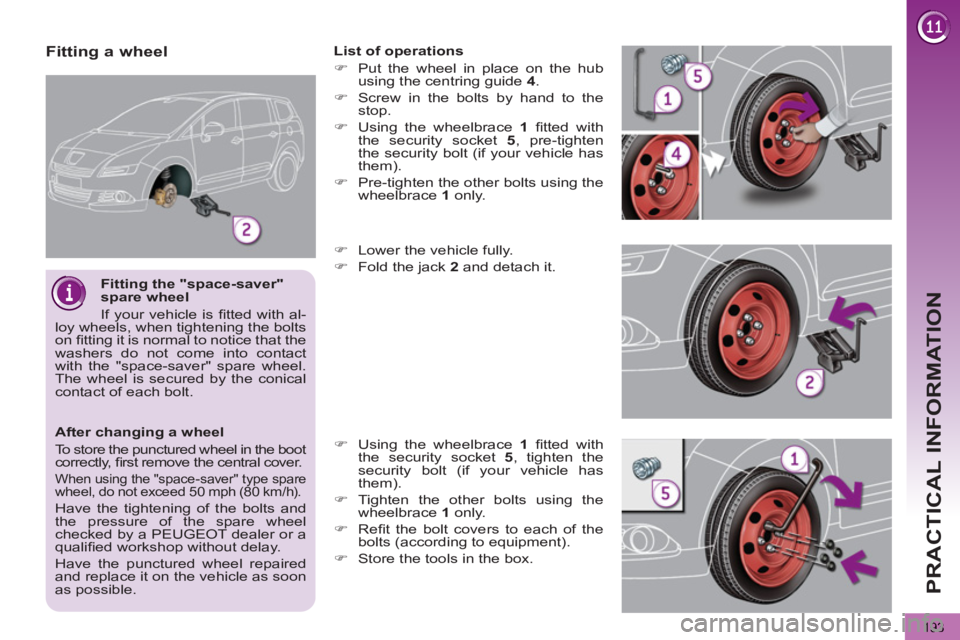
PRACTICAL INFORMATION
193
After changing a wheel
To store the punctured wheel in the boot
correctly, fi rst remove the central cover.
When using the "space-saver" type spare wheel, do not exceed 50 mph (80 km/h).
Have the tightening of the bolts and
the pressure of the spare wheel
checked by a PEUGEOT dealer or a
qualifi ed workshop without delay.
Have the punctured wheel repaired
and replace it on the vehicle as soon
as possible.
Fitting a wheel
List of operations
�)
Put the wheel in place on the hub
using the centring guide 4
.
�)
Screw in the bolts by hand to the
stop.
�)
Using the wheelbrace 1
fi tted with
the security socket 5
, pre-tighten
the security bolt (if your vehicle has
them).
�)
Pre-tighten the other bolts using the
wheelbrace 1
only.
�)
Lower the vehicle fully.
�)
Fold the jack 2
and detach it.
�)
Using the wheelbrace 1
fi tted with
the security socket 5
, tighten the
security bolt (if your vehicle has
them).
�)
Tighten the other bolts using the
wheelbrace 1
only.
�)
Refi t the bolt covers to each of the
bolts (according to equipment).
�)
Store the tools in the box.
Fitting the "space-saver"
spare wheel
If your vehicle is fi tted with al-
loy wheels, when tightening the bolts
on fi tting it is normal to notice that the
washers do not come into contact
with the "space-saver" spare wheel.
The wheel is secured by the conical
contact of each bolt.
Page 215 of 340
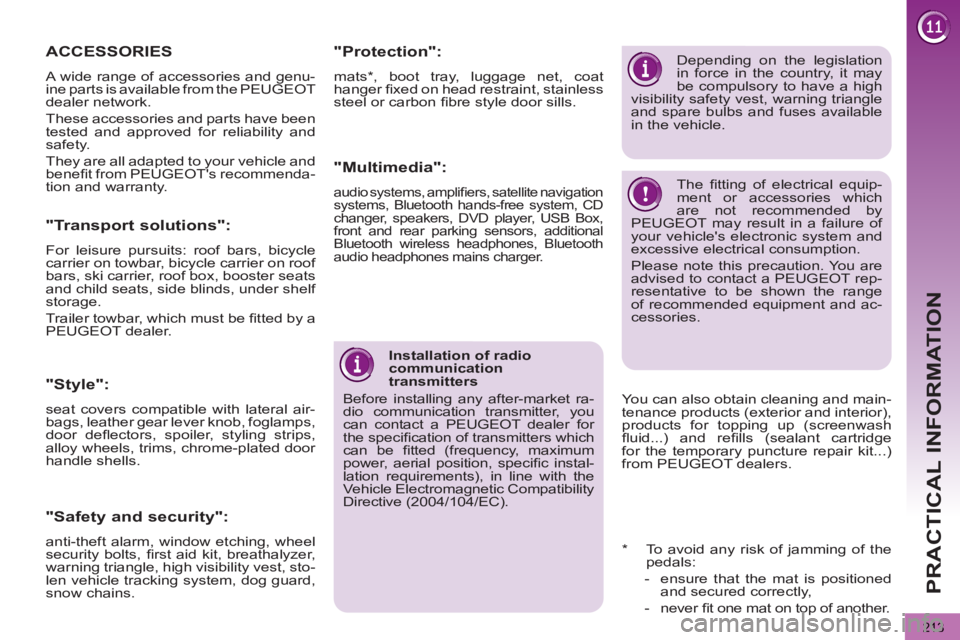
PRACTICAL INFORMATION
213
"Multimedia":
audio systems, amplifi ers, satellite navigation
systems, Bluetooth hands-free system, CD
changer, speakers, DVD player, USB Box,
front and rear parking sensors, additional
Bluetooth wireless headphones, Bluetooth
audio headphones mains charger.
Installation of radio
communication
transmitters
Before installing any after-market ra-
dio communication transmitter, you
can contact a PEUGEOT dealer for
the specifi cation of transmitters which
can be fi tted (frequency, maximum
power, aerial position, specifi c instal-
lation requirements), in line with the
Vehicle Electromagnetic Compatibility
Directive (2004/104/EC).
"Protection":
mats * , boot tray, luggage net, coat
hanger fi xed on head restraint, stainless
steel or carbon fi bre style door sills.
*
To avoid any risk of jamming of the
pedals:
- ensure that the mat is positioned
and secured correctly,
- never fi t one mat on top of another.
ACCESSORIES
A wide range of accessories and genu-
ine parts is available from the PEUGEOT
dealer network.
These accessories and parts have been
tested and approved for reliability and
safety.
They are all adapted to your vehicle and
benefi t from PEUGEOT's recommenda-
tion and warranty.
"Safety and security":
anti-theft alarm, window etching, wheel
security bolts, fi rst aid kit, breathalyzer,
warning triangle, high visibility vest, sto-
len vehicle tracking system, dog guard,
snow chains.
"Style":
seat covers compatible with lateral air-
bags, leather gear lever knob, foglamps,
door defl ectors, spoiler, styling strips,
alloy wheels, trims, chrome-plated door
handle shells.
Depending on the legislation
in force in the country, it may
be compulsory to have a high
visibility safety vest, warning triangle
and spare bulbs and fuses available
in the vehicle.
The fi tting of electrical equip-
ment or accessories which
are not recommended by
PEUGEOT may result in a failure of
your vehicle's electronic system and
excessive electrical consumption.
Please note this precaution. You are
advised to contact a PEUGEOT rep-
resentative to be shown the range
of recommended equipment and ac-
cessories.
"Transport solutions":
For leisure pursuits: roof bars, bicycle
carrier on towbar, bicycle carrier on roof
bars, ski carrier, roof box, booster seats
and child seats, side blinds, under shelf
storage.
Trailer towbar, which must be fi tted by a
PEUGEOT dealer.
You can also obtain cleaning and main-
tenance products (exterior and interior),
products for topping up (screenwash
fl uid...) and refi lls (sealant cartridge
for the temporary puncture repair kit...)
from PEUGEOT dealers.